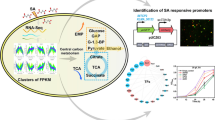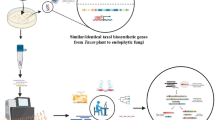Abstract
The oleaginous yeast Rhodosporidium toruloides, which belongs to the Pucciniomycotina subphylum in the Basidiomycota, has attracted strong interest in the biofuel community recently due to its ability to accumulate more than 60% of dry biomass as lipid under high-density fermentation. A 3,543-nucleotide (nt) DNA fragment of the glyceraldehyde-3-phosphate dehydrogenase gene (GPD1) was isolated from R. toruloides ATCC 10657 and characterized in details. The 1,038-nt mRNA derived from seven exons encodes an open reading frame (ORF) of 345 amino acids that shows high identity (80%) to the Ustilago maydis homolog. Notably, the ORF is composed of codons strongly biased towards cytosine at the Wobble position. GPD1 is transcriptionally regulated by temperature shock, osmotic stress, and carbon source. Nested deletion analysis of the GPD1 promoter by GFP reporter assay revealed that two regions, −975 to −1,270 and −1,270 to −1,429, upstream from the translational start site of GPD1 were important for responses to various stress stimuli. Interestingly, a 176-bp short fragment maintained 42.2% promoter activity of the 795-bp version in U. maydis whereas it was reduced to 17.4% in R. toruloides. The GPD1 promoter drove strong expression of a codon-optimized enhanced green fluorescent protein gene (RtGFP) and a codon-optimized hygromycin phosphotransferase gene (hpt-3), which was critical for Agrobacterium tumefaciens-mediated transformation in R. toruloides.






Similar content being viewed by others
References
Brachmann A, König J, Julius C, Feldbrügge M (2004) A reverse genetic approach for generating gene replacement mutants in Ustilago maydis. Mol Genet Genomics 272:216–226
Brefort T, Doehlemann G, Mendoza-Mendoza A, Reissmann S, Djamei A, Kahmann R (2009) Ustilago maydis as a pathogen. Annu Rev Phytopathol 47:423–445
Burns C, Gregory KE, Kirby M, Cheung MK, Riquelme M, Elliott TJ, Challen MP, Bailey A, Foster GD (2005) Efficient GFP expression in the mushrooms Agaricus bisporus and Coprinus cinereus requires introns. Fungal Genet Biol 42:191–199
Cangelosi GA, Best EA, Martinetti G, Nester EW (1991) Genetic analysis of Agrobacterium. Methods Enzymol 204:384–397
Chan CS, Guo L, Shih MC (2001) Promoter analysis of the nuclear gene encoding the chloroplast glyceraldehyde-3-phosphate dehydrogenase B subunit of Arabidopsis thaliana. Plant Mol Biol 46:131–141
Halaouli S, Record E, Casalot L, Hamdi M, Sigoillot JC, Asther M, Lomascolo A (2006) Cloning and characterization of a tyrosinase gene from the white-rot fungus Pycnoporus sanguineus, and overproduction of the recombinant protein in Aspergillus niger. Appl Microbiol Biotechnol 70:580–589
Harmsen MC, Schuren FH, Moukha SM, van Zuilen CM, Punt PJ, Wessels JG (1992) Sequence analysis of the glyceraldehyde-3-phosphate dehydrogenase genes from the basidiomycetes Schizophyllum commune, Phanerochaete chrysosporium and Agaricus bisporus. Curr Genet 22:447–454
Harris JI, Waters M (1976) Glyceraldehyde 3 phosphate dehydrogenase. In: Boyer PD (ed) The enzymes. Academic Press, New York, pp 1–49
Holland MJ, Holland JP (1978) Isolation and identification of yeast messenger ribonucleic acids coding for enolase, glyceraldehyde-3-phosphate dehydrogenase, and phosphoglycerate kinase. Biochemistry 17:4900–4907
Hooykaas PJJ, Roobol C, Schilperoort RA (1979) Regulation of the transfer of Ti-plasmids of Agrobacterium tumefaciens. J Gen Microbiol 110:99–109
Ianiri G, Wright SA, Castoria R, Idnurm A (2011) Development of resources for the analysis of gene function in Pucciniomycotina red yeasts. Fungal Genet Biol 48:685–695
Ji L, Jiang ZD, Liu Y, Koh CM, Zhang LH (2010) A simplified and efficient method for transformation and gene tagging of Ustilago maydis using frozen cells. Fungal Genet Biol 47:279–287
Kilaru S, Kües U (2005) Comparison of gpd genes and their protein products in basidiomycetes. Fungal Genet Newsl 52:18–23
Kilaru S, Hoegger P, Majcherczyk A, Burns C, Shishido K, Bailey A, Foster G, Kües U (2006) Expression of laccase gene lcc1 in Coprinopsis cinerea under control of various basidiomycetous promoters. Appl Microbiol Biotechnol 71:200–210
Lawrence GJ, Dodds PN, Ellis JG (2010) Transformation of the flax rust fungus, Melampsora lini: selection via silencing of an avirulence gene. Plant J 61:364–369
Lazo GR, Stein PA, Ludwig RA (1991) A DNA transformation-competent Arabidopsis genomic library in Agrobacterium. Nat Biotechnol 9:963–967
Levitt N, Briggs D, Gil A, Proudfoot NJ (1989) Definition of an efficient synthetic poly(A) site. Genes Dev 3:1019–1025
Liu H, Zhao X, Wang F, Li Y, Jiang X, Ye M, Zhao ZK, Zou H (2009) Comparative proteomic analysis of Rhodosporidium toruloides during lipid accumulation. Yeast 26:553–566
Liu Y, Koh CM, Sun L, Ji L (2011) Tartronate semialdehyde reductase defines a novel rate-limiting step in assimilation and bioconversion of glycerol in Ustilago maydis. PLoS One 6:e16438
Loubradou G, Brachmann A, Feldbrügge M, Kahmann R (2001) A homologue of the transcriptional repressor Ssn6p antagonizes cAMP signalling in Ustilago maydis. Mol Microbiol 40:719–730
Ma B, Mayfield MB, Gold MH (2001) The green fluorescent protein gene functions as a reporter of gene expression in Phanerochaete chrysosporium. Appl Environ Microbiol 67:948–955
Nitta Y, Miyazaki Y, Nakamura M, Iimura Y, Shishido K, Kajita S, Morohoshi N (2004) Molecular cloning of the promoter region of the glyceraldehyde-3-phosphate dehydrogenase gene that contributes to the construction of a new transformation system in Coriolus versicolor. Mycoscience 45:131–136
Ochman H, Gerber AS, Hartl DL (1988) Genetic applications of an inverse polymerase chain reaction. Genetics 120:621–623
Punt PJ, Dingemanse MA, Kuyvenhoven A, Soede RD, Pouwels PH, van den Hondel CA (1990) Functional elements in the promoter region of the Aspergillus nidulans gpdA gene encoding glyceraldehyde-3-phosphate dehydrogenase. Gene 93:101–109
Redkar RJ, Herzog RW, Singh NK (1998) Transcriptional activation of the Aspergillus nidulans gpdA promoter by osmotic signals. Appl Environ Microbiol 64:2229–2231
Sampaio JP, Gadanho M, Bauer R, Weiß M (2003) Taxonomic studies in the Microbotryomycetidae: Leucosporidium golubevii sp. nov., Leucosporidiella gen. nov. and the new orders Leucosporidiales and Sporidiobolales. Mycol Prog 2:53–68
Schuren FH, Wessels JG (1994) Highly-efficient transformation of the homobasidiomycete Schizophyllum commune to phleomycin resistance. Curr Genet 26:179–183
Smith TL, Leong SA (1990) Isolation and characterization of a Ustilago maydis glyceraldehyde-3-phosphate dehydrogenase-encoding gene. Gene 93:111–117
Tamura K, Peterson D, Peterson N, Stecher G, Nei M, Kumar S (2011) MEGA5: molecular evolutionary genetics analysis using maximum likelihood, evolutionary distance, and maximum parsimony methods. Mol Biol Evol 28:2731–2739
Tristan C, Shahani N, Sedlak TW, Sawa A (2011) The diverse functions of GAPDH: views from different subcellular compartments. Cell Signal 23:317–323
Tsuchiya K, Tajima H, Yamada M, Takahashi H, Kuwae T, Sunaga K, Katsube N, Ishitani R (2004) Disclosure of a pro-apoptotic glyceraldehyde-3-phosphate dehydrogenase promoter: anti-dementia drugs depress its activation in apoptosis. Life Sci 74:3245–3258
Tully M, Gilbert HJ (1985) Transformation of Rhodosporidium toruloides. Gene 36:235–240
Turcotte G, Kosaric N (1988) Biosynthesis of lipids by Rhodosporidium toruloides ATCC 10788. J Biotechnol 8:221–237
Vassileva A, Chugh DA, Swaminathan S, Khanna N (2001) Expression of hepatitis B surface antigen in the methylotrophic yeast Pichia pastoris using the GAP promoter. J Biotechnol 88:21–35
Webb CA, Szabo LJ, Bakkeren G, Garry C, Staples RC, Eversmeyer M, Fellers JP (2006) Transient expression and insertional mutagenesis of Puccinia triticina using biolistics. Funct Integr Genomics 6:250–260
Wolff AM, Arnau J (2002) Cloning of glyceraldehyde-3-phosphate dehydrogenase-encoding genes in Mucor circinelloides (syn. racemosus) and use of the gpd1 promoter for recombinant protein production. Fungal Genet Biol 35:21–29
Zhao X, Wu S, Hu C, Wang Q, Hua Y, Zhao ZK (2010) Lipid production from Jerusalem artichoke by Rhodosporidium toruloides Y4. J Ind Microbiol Biotechnol 37:581–585
Acknowledgments
This work was financially supported by the Singapore Economic Development Board and Temasek Trust. We thank especially Prof. Dr. Ursula Kües, Molecular Wood Biotechnology and Technical Mycology, Büsgen-Institute, Georg-August-University Göttingen, Göttingen, Germany, for many helpful suggestions for this manuscript, and Prof. Dr. Michael Feldbrügge, Institute for Microbiology, Heinrich-Heine-University Düsseldorf, Düsseldorf, Germany, for the gift of plasmid pMF2-3c.
Author information
Authors and Affiliations
Corresponding authors
Electronic supplementary material
Below is the link to the electronic supplementary material.
ESM 1
(DOCX 6.41 mb)
Rights and permissions
About this article
Cite this article
Liu, Y., Koh, C.M.J., Sun, L. et al. Characterization of glyceraldehyde-3-phosphate dehydrogenase gene RtGPD1 and development of genetic transformation method by dominant selection in oleaginous yeast Rhodosporidium toruloides . Appl Microbiol Biotechnol 97, 719–729 (2013). https://doi.org/10.1007/s00253-012-4223-9
Received:
Revised:
Accepted:
Published:
Issue Date:
DOI: https://doi.org/10.1007/s00253-012-4223-9




